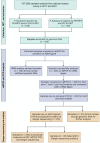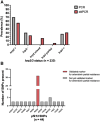A Countrywide Survey of hrp2/3 Deletions and kelch13 Mutations Co-occurrence in Ethiopia
- PMID: 39083679
- PMCID: PMC11646589
- DOI: 10.1093/infdis/jiae373
A Countrywide Survey of hrp2/3 Deletions and kelch13 Mutations Co-occurrence in Ethiopia
Abstract
Malaria elimination relies on detection of Plasmodium falciparum histidine-rich proteins 2/3 (HRP2/3) through rapid diagnostic tests (RDTs) and treatment with artemisinin combination therapies (ACTs). Data from the Horn of Africa suggest increasing hrp2/3 gene deletions and ACT partial resistance kelch13 (k13) mutations. To assess this, 233 samples collected during a national survey from 7 regions of Ethiopia were studied for hrp2/3 deletions with droplet digital polymerase chain reaction (ddPCR) and k13 mutations with DNA sequencing. Approximately 22% of the study population harbored complete hrp2/3 deletions by ddPCR. Thirty-two of 44 of k13 single-nucleotide polymorphisms identified were R622I associated with ACT partial resistance. Both hrp2/3 deletions and k13 mutations associated with ACT partial resistance appear to be co-occurring, especially in Northwest Ethiopia. Ongoing national surveillance relying on accurate laboratory methods are required to elaborate the genetic diversity of P. falciparum.
Keywords: artemisinin; histidine-rich protein 2; kelch13; malaria; rapid diagnostic tests.
© The Author(s) 2024. Published by Oxford University Press on behalf of Infectious Diseases Society of America.
Conflict of interest statement
Potential conflicts of interest. All authors: No reported conflicts. All authors have submitted the ICMJE Form for Disclosure of Potential Conflicts of Interest. Conflicts that the editors consider relevant to the content of the manuscript have been disclosed.
Figures




Similar articles
-
Expansion of artemisinin partial resistance mutations and lack of histidine rich protein-2 and -3 deletions in Plasmodium falciparum infections from Rukara, Rwanda.Malar J. 2024 May 16;23(1):150. doi: 10.1186/s12936-024-04981-4. Malar J. 2024. PMID: 38755607 Free PMC article.
-
The spread of molecular markers of artemisinin partial resistance and diagnostic evasion in Eritrea: a retrospective molecular epidemiology study.Lancet Microbe. 2025 Feb;6(2):100930. doi: 10.1016/S2666-5247(24)00172-1. Epub 2024 Dec 6. Lancet Microbe. 2025. PMID: 39653047 Free PMC article.
-
Molecular surveillance of Kelch 13 polymorphisms in Plasmodium falciparum isolates from Kenya and Ethiopia.Malar J. 2024 Jan 29;23(1):36. doi: 10.1186/s12936-023-04812-y. Malar J. 2024. PMID: 38287365 Free PMC article.
-
Artemisinin Action and Resistance in Plasmodium falciparum.Trends Parasitol. 2016 Sep;32(9):682-696. doi: 10.1016/j.pt.2016.05.010. Epub 2016 Jun 9. Trends Parasitol. 2016. PMID: 27289273 Free PMC article. Review.
-
Updates on k13 mutant alleles for artemisinin resistance in Plasmodium falciparum.J Microbiol Immunol Infect. 2018 Apr;51(2):159-165. doi: 10.1016/j.jmii.2017.06.009. Epub 2017 Jun 29. J Microbiol Immunol Infect. 2018. PMID: 28711439 Review.
Cited by
-
Molecular surveillance of Plasmodium falciparum histidine-rich protein 2/3 gene deletions in Mozambique, 2023.Malar J. 2024 Dec 26;23(1):402. doi: 10.1186/s12936-024-05230-4. Malar J. 2024. PMID: 39725959 Free PMC article.
-
Deletion of target gene (histidine-rich protein 2/3) for Plasmodium falciparum rapid diagnostic tests in Amhara region, Ethiopia: a cross-sectional study.Malar J. 2025 Aug 2;24(1):250. doi: 10.1186/s12936-025-05485-5. Malar J. 2025. PMID: 40753217 Free PMC article.
-
Performance of BIOCREDIT Pf/Pv lactate dehydrogenase-based malaria rapid diagnostic test among pregnant women with suspected malaria infection in Bahir Dar City Administration, northwest Ethiopia.PLoS One. 2025 May 7;20(5):e0322362. doi: 10.1371/journal.pone.0322362. eCollection 2025. PLoS One. 2025. PMID: 40333746 Free PMC article.
-
Artemisinin resistant kelch13 R622I and RDT negativity approaching predominance in northern Ethiopia and emerging C580Y of African origin threaten falciparum malaria control.medRxiv [Preprint]. 2025 Jun 23:2025.06.23.25330019. doi: 10.1101/2025.06.23.25330019. medRxiv. 2025. PMID: 40666313 Free PMC article. Preprint.
-
Artemisinin-resistant malaria.Clin Microbiol Rev. 2024 Dec 10;37(4):e0010924. doi: 10.1128/cmr.00109-24. Epub 2024 Oct 15. Clin Microbiol Rev. 2024. PMID: 39404268 Review.
References
-
- World Health Organization . World malaria report 2022. Geneva, Switzerland: World Health Organization, 2022.
-
- Venkatesan P. The 2023 WHO world malaria report. Lancet Microbe 2024; 5:e214. - PubMed
MeSH terms
Substances
Grants and funding
LinkOut - more resources
Full Text Sources
Research Materials

